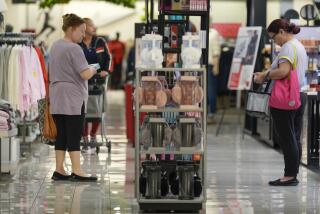Continuing Low Consumer Prices Help to Push Retail Sales Down 0.1% in May
- Share via
WASHINGTON — Retail sales slipped 0.1% in May, reflecting continuing low consumer prices paired with an unexpected slowdown in auto and housing materials sales, the Commerce Department said today.
In a separate report, the department said U.S. businesses plan to spend 1.3% less this year than in 1985 for capital goods. The slowdown was centered in mining and petroleum industries, hit hard by the collapse in oil prices.
Advance estimates of U.S. retail sales last month, adjusted for seasonal differences, totaled $117.05 billion, down from a revised $117.14 in April, according to a Census Bureau report.
Two retail sectors that expanded rapidly in April, auto and housing materials, slowed markedly, to the surprise of analysts who had expected continued gains.
Building Materials Fall
Automotive sales advanced a slim 0.6% last month after an upwardly revised 4.3% surge in April due to low-interest financing incentives.
Building materials, hardware and garden supplies fell back a surprising 4.2% after a 4.6% advance in April, despite a continuing brisk level of new and existing home sales.
Furniture and home appliance sales, on the other hand, advanced 2.8%.
Gasoline service stations, which saw their sales fall back 7.4% in April, experienced a 2% setback in May, despite the bottoming out of gasoline prices at the pump, the report showed.
“The decline in consumer prices means that spending--after inflation--is actually growing,” Commerce Secretary Malcolm Baldrige said. “Recent strong gains in real disposable income . . . and high levels of consumer confidence indicate continued gains in consumer spending.”
Sales Setback
Consumer prices decreased by 0.2% in April but May figures have not yet been compiled.
Last month’s sales setback was the first since March, when they fell 0.4%, according to revisions contained in the report. Total sales over the past three months were 0.2% below the previous three months but 3.1% above the same period a year ago.
Plans for real capital spending for 1986, adjusted for inflation, involved the expenditure of an estimated $374.77 billion, down from $379.74 billion in 1985, according to a poll conducted in April and May by the Bureau of Economic Analysis.
More to Read
Inside the business of entertainment
The Wide Shot brings you news, analysis and insights on everything from streaming wars to production — and what it all means for the future.
You may occasionally receive promotional content from the Los Angeles Times.










